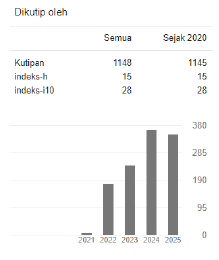Deadly Performance of Hegemonic Masculinity: A Study of Jeffrey Dahmer
 https://doi.org/10.54012/jcell.v4i4.485
https://doi.org/10.54012/jcell.v4i4.485
 Abstract views: 741
Abstract views: 741
 PDF downloads: 491
PDF downloads: 491
Keywords:
hegemonic masculinity, gender performativity, queer, Jeffrey DahmerAbstract
This research examines the portrayal of masculinity in Dahmer – Monster: The Jeffrey Dahmer Story (2022), emphasizing on how Jeffrey Dahmer performs hegemonic masculine traits despite his marginalized sexual identity. Using a qualitative textual analysis method, this research applies R.W. Connell’s theory of hegemonic masculinity and Judith Butler’s theory of gender performativity to analyze key scenes depicting Dahmer’s criminal acts. This study found that Dahmer consistently embodies hegemonic masculine traits, such as domination, control, and power, as well as the objectification of the others. His murdering acts are not isolated events, but rather ritualized performances that reaffirm masculine dominance through repeated acts of violence. Despite his queerness puts him outside the heteronormative masculinity, it does not subvert the patriarchal structure, in fact, it coexists with it through his acts. This study highlights the adaptability of hegemonic masculinity across different heteronormative sexual identities and challenges the assumption that queerness inherently resists dominant gender norms. The implications extend to the fields of gender studies, media studies, true crime narratives, and criminology studies, urging scholars and audiences to reconsider the intersection of queerness, race, and masculinity in representation of crime narrative. Future research is encouraged to explore further on the audiences’ reception toward perpetrators across diverse identity and cultural context.
Downloads
References
Arya, A. (2020). An Overview of Textual Analysis as a Research Method for Cultural Studies. Peer-Reviewed, Refereed, Indexed Journal with IC, 6(3), 2455–0620.
Barnard, I. (2000). The Racialization of Sexuality: The Queer Case of Jeffrey Dahmer. Thamyris Overcoming Boundaries: Ethnicity, Gender and Sexuality, 7(1 & 2), 67–97. https://digitalcommons.chapman.edu/english_books
Boucher, G. (2006). The Politics of Performativity: A Critique of Judith Butler. Parrhesia, 1(1), 112–141.
Butler, J. (1988). Performative Acts and Gender Constitution: An Essay in Phenomenology and Feminist Theory. Theatre Journal, 40(4), 519–531. https://www.jstor/stable/3207893
Butler, J. (1999). Gender Trouble: Feminism and the Subversion of Identity. Routledge.
Chéze, E. (2009). Jeffrey Lionel Dahmer: A Psychobiographical Study [Master’s Thesis]. Nelson Mandela Metropolitan University.
Connell, R. W. (1998). Masculinities. Gender and Society, 12(4), 474–477. https://www.jstor.org/stable/190181
Connell, R. W., & Messerschmidt, J. W. (2005). Hegemonic masculinity rethinking the concept. Gender and Society, 19(6), 829–859. https://doi.org/10.1177/0891243205278639
Cuklanz, L., & Erol, A. (2021). The Shifting Image of Hegemonic Masculinity in Contemporary U.S. Television Series. International Journal of Communication, 15, 545–562. http://ijoc.org.
Demetriou, D. Z. (2001). Connell’s Concept of Hegemonic Masculinity: A Critique. Theory and Society, 30(3), 337–361. https://about.jstor.org/terms
Feinberg, D. (2022, September 22). ‘Dahmer — Monster: The Jeffrey Dahmer Story’ Review: Ryan Murphy, Netflix, Rinse, Repeat. The Hollywood Reporter. https://www.hollywoodreporter.com/tv/tv-reviews/dahmer-monster-the-jeffrey-dahmer-story-review-ryan-murphy-evan-peters-1235225967/
Fišerová, P. (2019). From Toxic to Politically Correct: Masculinities in American Psycho and Darkly Dreaming Dexter. Humanities and Social Sciences Review, 8(2), 519–534. https://universitypublications.net/hssr/0802/pdf/P8RS193.pdf
Harris, B. (2021). Toxic Masculinity: An Exploration of Traditional Masculine Norms in Relation to Mental Health Outcomes and Help-Seeking in Relation to Mental Health Outcomes and Help-Seeking Behaviors in College-Aged Males [Senior Thesis, University of South Carolina]. https://scholarcommons.sc.edu/senior_theses/431
He, L. (2017). The Construction of Gender: Judith Butler and Gender Performativity. Advances in Social Science, Education and Humanities Research, 124, 682–685.
Inside Edition. (2018, November 28). Inside the Mind of Jeffrey Dahmer: Serial Killer’s Chilling Jailhouse Interview. [Broadcast]. In Inside Edition. Inside Edition. https://www.youtube.com/watch?v=iWjYsxaBjBI&t=89s
Jabeen, S. (2018). Concept of Masculinity in Men. Annals of Social Sciences & Management Studies, 1(4). https://doi.org/10.19080/asm.2018.01.555570
King-Carroll, K. (2022, October 11). Racism and Homophobia Enabled Jeffrey Dahmer’s Crime. The Washington Post. https://www.washingtonpost.com/made-by-history/2022/10/11/racism-homophobia-enabled-jeffrey-dahmers-crimes/
Krammer, S. M. S. (2024). From Trauma to Entertainment: An Examination of Netflix’s Dahmer—Monster: The Jeffrey Dahmer Story Series. Business Ethics Quarterly, 34(2), 369–373. https://doi.org/10.1017/beq.2023.31
Malonda-Vidal, E., Samper-García, P., Llorca-Mestre, A., Muñoz-Navarro, R., & Mestre-Escrivá, V. (2021). Traditional masculinity and aggression in adolescence: its relationship with emotional processes. International Journal of Environmental Research and Public Health, 18(18). https://doi.org/10.3390/ijerph18189802
Merdassa, A. B. (2024). Traditional masculinity, peer pressure, and sensation seeking as correlates of risky behaviours. International Journal of Adolescence and Youth, 29(1). https://doi.org/10.1080/02673843.2023.2298087
Nichols, D. S. (2006). Tell Me a Story: MMPI Responses and Personal Biography in the Case of a Serial Killer. Journal of Personality Assessment, 86(3), 242–262.
Pratama, P. I. A., & Ningsih, T. W. R. (2021). TRAITS OF MASCULINITY AS DEPICTED IN AVENGERS: ENDGAME MOVIE. ISLLAC : Journal of Intensive Studies on Language, Literature, Art, and Culture, 5(2), 251–261. http://creativecommons.org/licenses/BY/4.0/
Psychological Association, A. (2018). Guidelines for Psychological Practice with Boys and Men. http://www.apa.org/about/policy/psychological-practice-boys-men-guidelines.pdf.
Ramsland, K. (2010). The Forensic Psychology of Criminal Minds. Penguin Publishing Group.
Salim, M., & Jahangir, J. S. (2024). The “Masculine” Female Serial Killer: Monstrosity in Val McDermid’s The Mermaids Singing. IIS Univ.J.A, 13(3), 73–83.
Schlesinger, L. B., Kassen, M., Blair Mesa, V., & Pinizzotto, A. J. (2010). Ritual and Signature in Serial Sexual Homicide. J Am Acad Psychiatry Law, 38(2), 239–285.
Schmidt, M. A. (1994). Dahmer Discourse and Gay Identity: The Paradox of Queer Politics. Critical Sociology, 20(3), 81–105. https://doi.org/10.1177/089692059402000305
Steiner, K. (2024). Serial Killers, Media Involvement, and the Layers of Masculinity. In K.-A. Münderlein (Ed.), Crime Fiction, Femininities and Masculinities: Proceedings of the Eight Captivating Criminality Conference (Vol. 38). University of Bamberg Press. https://doi.org/10.20378/irb-92502
Strause, J. (2022, September 28). Jeffrey Dahmer Victim’s Family Speaks Out About Netflix Series. Hollywood Reporter. https://www.hollywoodreporter.com/tv/tv-news/jeffrey-dahmer-netflix-tv-show-victim-family-speaks-out-1235228196/
Yang, Y. (2020). What’s Hegemonic about Hegemonic Masculinity? Legitimation and Beyond. Sociological Theory, 38(4), 318–333. https://doi.org/10.1177/0735275120960792
Downloads
Published
How to Cite
Issue
Section
License
Copyright (c) 2025 Adhysti Keinar Phattika

This work is licensed under a Creative Commons Attribution-ShareAlike 4.0 International License.
All articles published in the Journal Corner of Education, Linguistics, and Literature are licensed under the Creative Commons Attribution-ShareAlike License (CC BY-SA).

















